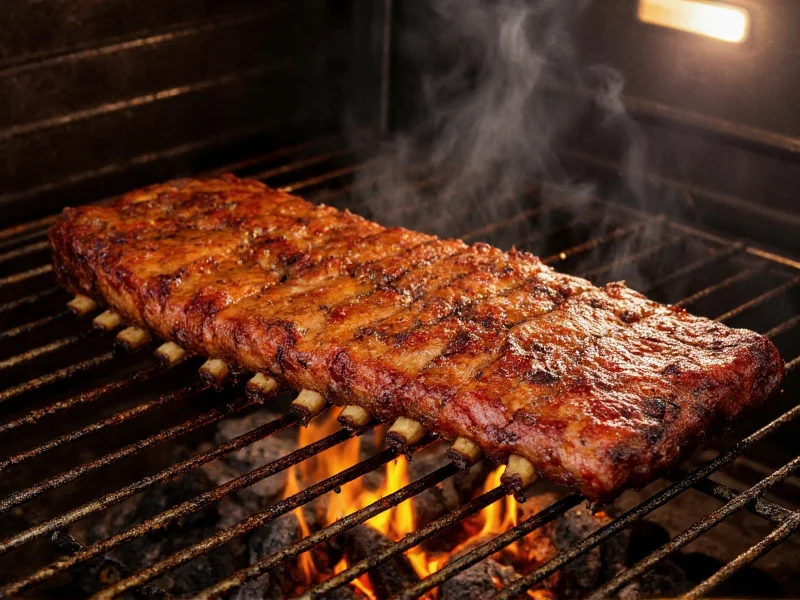Perfectly cooked oven ribs require precise temperature control. Many home cooks make the mistake of cooking ribs at too high a temperature, resulting in tough, dry meat. Understanding the science behind rib preparation transforms this challenging cut into a tender, flavorful masterpiece. This guide provides evidence-based temperature recommendations that balance food safety with optimal texture and flavor development.
The Science Behind Rib Cooking Temperatures
Ribs contain significant collagen and connective tissue that must break down for tender results. This transformation happens through collagen-to-gelatin conversion, which begins around 160°F (71°C) but occurs most effectively between 195°F-205°F (90°C-96°C). Cooking at lower temperatures (225°F-275°F) allows this process to happen gradually without drying out the meat.
Unlike other pork cuts where 145°F (63°C) is sufficient for safety, ribs require higher internal temperatures to achieve tenderness. The USDA confirms that pork is safe to eat at 145°F, but for ribs specifically, you need to continue cooking to 195°F-205°F for proper texture. This extended cooking time at controlled temperatures is what separates mediocre ribs from exceptional ones.
Historical Evolution of Rib Cooking Techniques
Modern oven methods build upon centuries of barbecue tradition. Understanding this progression reveals why precise temperature control emerged as critical for home cooking:
| Era | Primary Method | Temperature Control | Key Development |
|---|---|---|---|
| Pre-1900s | Open-pit wood fires | None (visual estimation) | Slow cooking over indirect heat for 12+ hours; relied on experience |
| 1930s-1950s | Brick pits/smokers | Rudimentary (thermometer adoption) | Introduction of consistent 225°F-250°F ranges for collagen breakdown |
| 1960s-1980s | Offset smokers | Moderate (dampers/gauges) | "Low-and-slow" formalized; 225°F established as barbecue standard |
| 1990s-Present | Oven adaptation | Precise (digital thermometers) | 3-2-1 method optimized for home ovens; USDA food safety integration |
This evolution, documented by Texas A&M Meat Science researchers, shows how temperature precision directly correlates with improved texture outcomes. Early methods required extensive experience to avoid under/overcooking, while modern digital tools democratize consistent results. The 225°F-275°F range emerged as the scientific sweet spot balancing collagen conversion and moisture retention.
Temperature Options Compared
Three primary temperature approaches work well for oven ribs, each with distinct advantages:
| Temperature Range | Cooking Time | Texture Result | Best For |
|---|---|---|---|
| 225°F (107°C) | 4-6 hours | Ultra-tender, fall-off-the-bone | Traditional low and slow method |
| 250°F (121°C) | 3-4 hours | Balanced tenderness with structure | Most versatile approach |
| 275°F (135°C) | 2.5-3.5 hours | Firm but tender, slightly chewy | Time-constrained cooking |
Contextual Limitations: When Standard Methods Require Adjustment
While the 225°F-275°F range works for most home ovens, specific conditions demand protocol modifications. Ignoring these boundaries risks texture failures:
- High-Altitude Cooking (Above 3,000 ft): Water boils at lower temperatures, slowing collagen conversion. Increase cooking time by 25% without raising oven temperature. At 5,000 feet, cook 225°F ribs for 5-7.5 hours instead of 4-6 hours. (Source: Colorado State University Extension)
- Convection Ovens: Circulating air accelerates cooking. Reduce temperature by 25°F (e.g., set to 200°F instead of 225°F) to prevent exterior drying before collagen fully converts. (Source: University of Nebraska-Lincoln Food Safety)
- Extremely Lean Rib Cuts: Modern selective breeding produces leaner ribs prone to drying. Add ½ cup liquid to foil wrap and reduce temperature to 200°F for 6-8 hours. (Source: National Pork Board)
Preparing Ribs for Oven Cooking
Before setting your oven temperature for ribs, proper preparation ensures optimal results:
- Remove the membrane: Peel off the silver skin from the bone side for better seasoning penetration and more even cooking
- Dry brine: Apply salt 12-24 hours before cooking to enhance flavor and texture
- Season generously: Use a balanced rub with salt, sugar, and spices
- Room temperature start: Let ribs sit at room temperature for 30-60 minutes before cooking
The 3-2-1 Method for Perfect Oven Ribs
This popular technique works exceptionally well at 225°F-250°F:
- 3 hours uncovered: Allows smoke flavor (if using liquid smoke) to penetrate and forms a bark
- 2 hours wrapped: Cook in foil with liquid (apple juice, broth) to steam and tenderize
- 1 hour uncovered: Returns texture to the exterior and sets any sauce
For those wondering how long to cook ribs at 275 degrees, reduce the first stage to 2 hours, keep the wrapped stage at 2 hours, and finish with 30-45 minutes uncovered.
How to Tell When Ribs Are Done
Don't rely solely on time—use these indicators to determine when your oven baked ribs have reached perfection:
- Bend test: Lift ribs with tongs; they should bend freely and cracks may appear in the bark
- Internal temperature: 195°F-205°F (90°C-96°C) measured between bones
- Meat retraction: Bones will protrude slightly as meat shrinks back
- Fork tenderness: A fork should slide in with slight resistance, not fall apart
Finishing Techniques for Restaurant-Quality Results
After reaching the proper internal temperature for cooked ribs, elevate your results with these finishing touches:
- Glaze application: Brush on sauce during the last 15-30 minutes to prevent burning
- Broiler finish: 2-3 minutes under the broiler creates caramelization
- Resting period: Allow 10-15 minutes before cutting to redistribute juices
- Slicing technique: Cut between bones with a sharp knife for clean presentation
Troubleshooting Common Rib Problems
Even with the correct oven temperature for pork ribs, issues can arise:
- Tough ribs: Undercooked—return to oven and continue cooking until reaching 195°F+
- Dry ribs: Overcooked or too high temperature—next time reduce temperature by 25°F
- Burnt exterior: Temperature too high or sauce applied too early—use foil during cooking
- Uneven cooking: Rotate pan halfway through cooking for even heat distribution
Food Safety Considerations
While pursuing the perfect texture, never compromise food safety. The USDA confirms pork is safe at 145°F, but ribs require higher temperatures for tenderness. Use an accurate instant-read thermometer to verify internal temperature. Always maintain proper food handling practices when preparing ribs to prevent cross-contamination.











 浙公网安备
33010002000092号
浙公网安备
33010002000092号 浙B2-20120091-4
浙B2-20120091-4